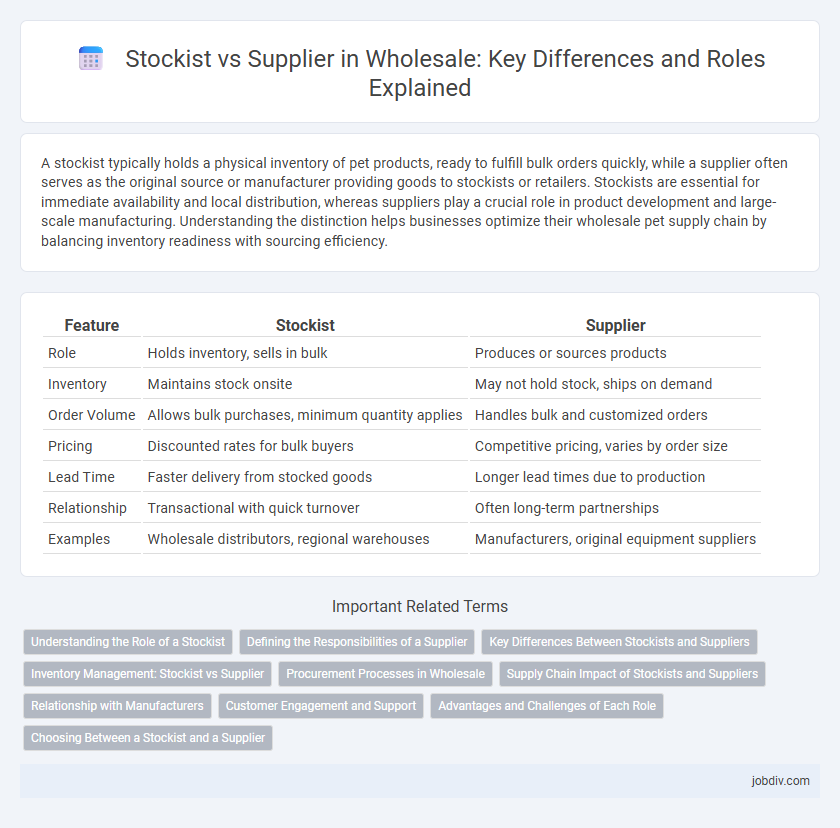A stockist typically holds a physical inventory of pet products, ready to fulfill bulk orders quickly, while a supplier often serves as the original source or manufacturer providing goods to stockists or retailers. Stockists are essential for immediate availability and local distribution, whereas suppliers play a crucial role in product development and large-scale manufacturing. Understanding the distinction helps businesses optimize their wholesale pet supply chain by balancing inventory readiness with sourcing efficiency.
Table of Comparison
| Feature | Stockist | Supplier |
|---|---|---|
| Role | Holds inventory, sells in bulk | Produces or sources products |
| Inventory | Maintains stock onsite | May not hold stock, ships on demand |
| Order Volume | Allows bulk purchases, minimum quantity applies | Handles bulk and customized orders |
| Pricing | Discounted rates for bulk buyers | Competitive pricing, varies by order size |
| Lead Time | Faster delivery from stocked goods | Longer lead times due to production |
| Relationship | Transactional with quick turnover | Often long-term partnerships |
| Examples | Wholesale distributors, regional warehouses | Manufacturers, original equipment suppliers |
Understanding the Role of a Stockist
A stockist plays a crucial role in wholesale by maintaining inventory of products from various suppliers, ensuring ready availability for retailers or smaller businesses. Unlike suppliers who manufacture or directly provide goods, stockists act as intermediaries managing bulk stock and facilitating efficient distribution. Their role optimizes supply chain operations by reducing lead times and improving product accessibility in the market.
Defining the Responsibilities of a Supplier
A supplier in wholesale is responsible for providing products directly to retailers or stockists, ensuring consistent inventory availability and quality control. They manage the procurement, storage, and timely delivery of goods while maintaining supplier relationships and negotiating pricing. Suppliers often oversee product sourcing, compliance with regulations, and logistical coordination to support the supply chain.
Key Differences Between Stockists and Suppliers
Stockists maintain inventory of products ready for immediate sale, ensuring faster delivery times, while suppliers typically manufacture or source goods and may not hold stock. Stockists purchase in bulk from suppliers to distribute smaller quantities to retailers, acting as intermediaries in the supply chain. The primary difference lies in stockists managing warehousing and inventory, whereas suppliers focus on production and procurement.
Inventory Management: Stockist vs Supplier
Stockists maintain physical inventory, enabling faster order fulfillment and reduced lead times, crucial for efficient wholesale operations. Suppliers often manage inventory remotely, relying on just-in-time delivery systems that can optimize stock levels but may increase the risk of delays. Effective inventory management hinges on the balance between stockist availability and supplier logistics to ensure seamless product flow and minimize stockouts.
Procurement Processes in Wholesale
Stockists manage inventory by purchasing bulk products from suppliers and retaining stock for immediate distribution, enhancing procurement efficiency in wholesale channels. Suppliers focus on producing or sourcing goods, fulfilling large orders directly to stockists or retailers, which streamlines the supply chain and reduces lead times. Effective procurement processes hinge on clear roles where stockists maintain availability while suppliers ensure consistent product flow, optimizing wholesale operations.
Supply Chain Impact of Stockists and Suppliers
Stockists play a critical role in the wholesale supply chain by holding inventory closer to end buyers, reducing lead times and enhancing product availability, which minimizes disruptions and supports just-in-time retail strategies. Suppliers focus on manufacturing and primary distribution, influencing supply chain efficiency through production capacity and raw material sourcing. The combined functionality of stockists and suppliers ensures a balanced flow of goods, optimizing inventory management and reducing overall supply chain costs.
Relationship with Manufacturers
Stockists maintain a close relationship with manufacturers by purchasing large quantities of products for resale, often holding inventory to ensure immediate availability for retailers. Suppliers act as intermediaries connecting manufacturers with stockists or retailers, focusing on distribution rather than inventory ownership. This distinction shapes how each interacts with manufacturers, with stockists investing in long-term partnerships to secure stock, while suppliers prioritize efficient supply chain management.
Customer Engagement and Support
Stockists provide localized inventory, enabling faster delivery and personalized customer engagement through direct interactions and tailored support. Suppliers often manage bulk orders with standardized service, focusing on efficiency rather than individualized customer care. Effective wholesale strategies balance stockist responsiveness and supplier reliability to enhance overall customer satisfaction.
Advantages and Challenges of Each Role
Stockists maintain inventory, ensuring immediate product availability, which reduces lead times and supports quicker order fulfillment, but they face challenges like higher storage costs and inventory management risks. Suppliers focus on product manufacturing and distribution, enabling scalability and a broader product range, though they often experience longer delivery times and less control over retail-level stock. Both roles are crucial in wholesale, balancing efficiency, risk, and supply chain responsiveness.
Choosing Between a Stockist and a Supplier
Choosing between a stockist and a supplier depends on inventory control and delivery speed needs. Stockists maintain ready-to-sell inventory, enabling faster order fulfillment and reducing lead times. Suppliers typically provide products directly from manufacturers, offering broader product ranges but with longer delivery schedules.
Stockist vs Supplier Infographic

 jobdiv.com
jobdiv.com